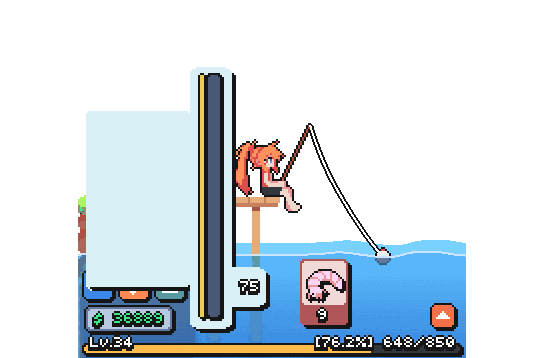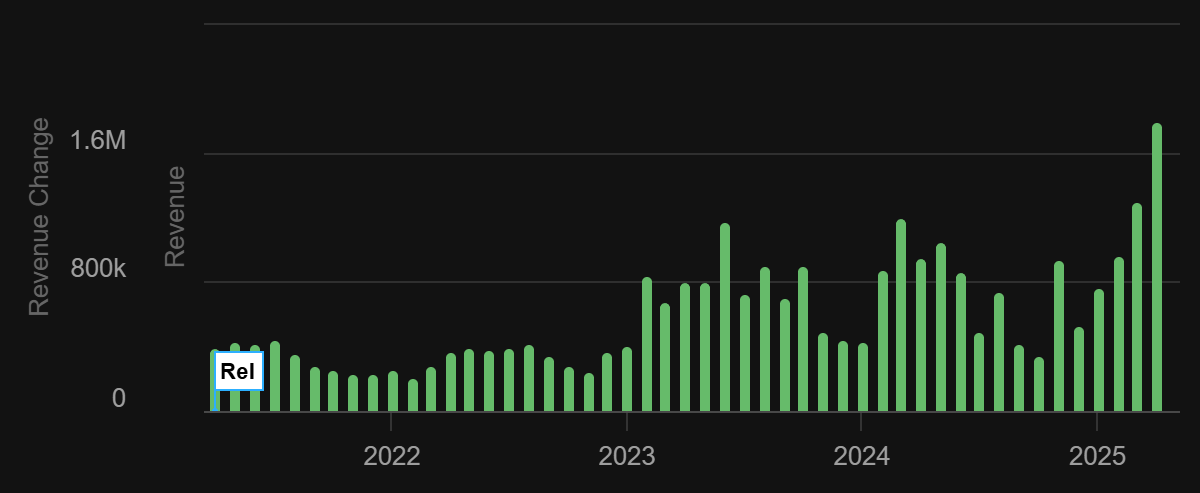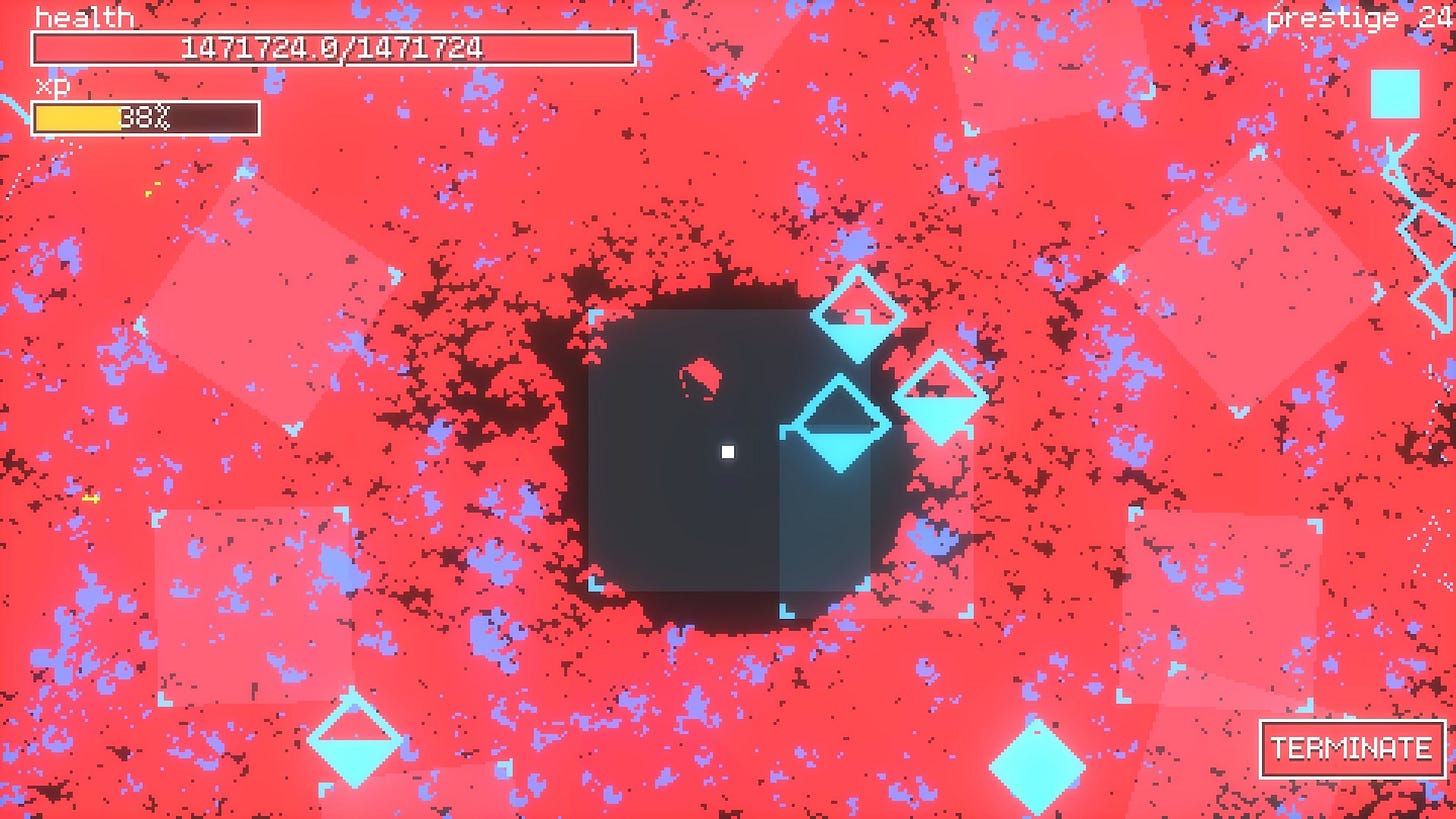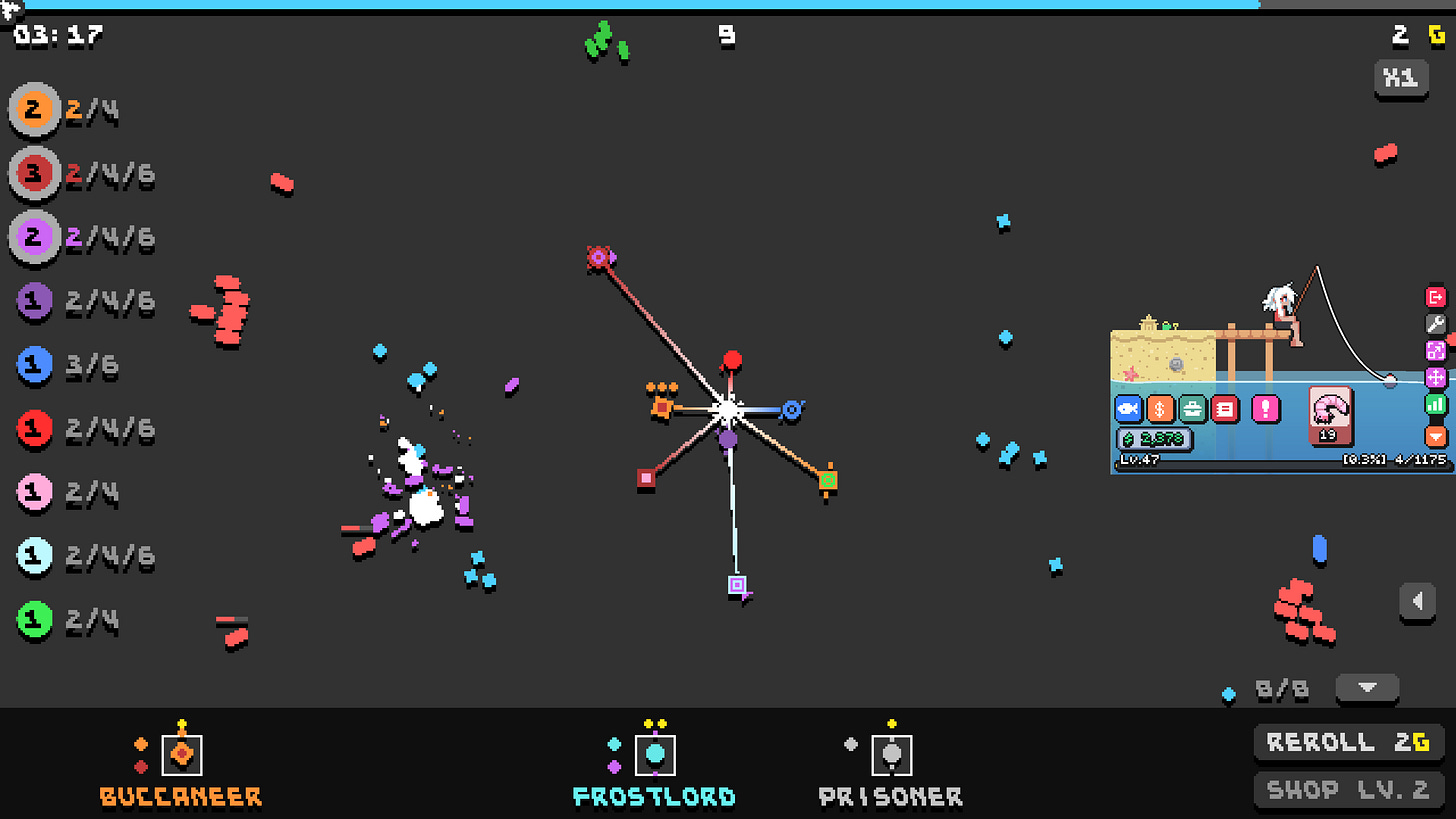The Idle Joys of Games You Don't Play
A Q&A with the creator of a clever idle game about patience and distraction
I caught 2,000 fish this week.
Or, at least, this girl who lives in the corner of my computer screen did.

I don’t know her name, but she’s the protagonist of Cornerpond. It’s a new “idle” game that hit the New & Trending chart on Steam this week—really more of a toy than a game. The app sits atop your other windows in a corner of your desktop while your character automatically reels in fish.
Sometimes you have to solve a little target-clicking minigame to help your character haul in a big one. But mostly you just watch. Maybe refill your bait every once in a while. There is a goal: you sell fish and buy upgrades so you can catch bigger and bigger fish. And the ultimate payoff is… well, who cares? It’s fishing. The experience is the point.
I could spend more time trying to explain it, but just watch the below video.
This is the only Steam trailer I’ve ever seen that includes 30 seconds of the developer typing into Notepad.
In some ways, Cornerpond is nothing like real fishing. At one point, using nothing but a fishing rod and a worm as bait, I hauled a 2,000 pound beluga whale out of the Arctic and then sold it within seconds in an illegal whale meat market.
But in other ways, the game manages to evoke strangely real and familiar emotions. Once, in the middle of answering an email, a chirp alerted me that a real whopper was on the line. A meter indicated it would take 900 clicks to successfully reel it in. This was a massive fish—an absolute barn door. I knew my rod wasn’t upgraded enough for the fight, but I clicked as quickly as I could anyway. As the leviathan slipped away, I found myself crunching numbers to see how much I’d need to gear up to nab the beast if and when I meet him again. That bastard’s not gonna catch me slipping next time, I mused. One minute I was appending “Best, Ryan” to a Gmail draft, and the next I’d gone full Captain Ahab.
All of the games from Cornerpond creator foolsroom are strange and creative little genre-benders like this. FLERP is sort of like Teamfight Tactics combined with Vampire Survivors. Mouselash is a roguelike where you fight by whipping enemies with your mouse cursor. Whackerball is Breakout if the ball had a gun (I swear I’m not making these up).
All of this is to say: this dev is clearly a thoughtful artist. So when I reached out to foolsroom for an interview, I was surprised by how candid he was about the role commercial motivations played in Cornerpond’s creation.
“I ultimately decided to make one of these desktop idler games because it's a genre/concept that is simple and easy to make, and one that seemed hot in the market,” foolsroom wrote to me in an email. “I wasn't really confident it would be successful, but I figured the idea was so simple and easy that I could make it in a short time frame, so it wouldn't need to sell a ton to be a success.”
So far, that bet is paying off. With over 270 reviews in its first few days on Steam, Cornerpond has already garnered more attention than foolsroom’s last three games combined, and will probably outperform his first hit game, FLERP, in the coming weeks. It’s not a massive hit—this is a $3 game, after all—but foolsroom is right that idlers are a popular and probably underserved genre on Steam.
The genre’s been around since 2002, when Eric Fredricksen released Progress Quest as a parody of the grindy gameplay in Everquest. In 2013 Julien "Orteil" Thiennot’s Cookie Clicker was the genre’s first breakout hit, and in the 2010s a slew of idlers followed. In between 2019–2021 especially, there was a wave of free-to-play takes on the genre (IdleOn, Shop Titans, and Idle Champions) that grossed tens of millions in sales.

In some ways, it feels wrong to group these games together with more recent experiments in the genre from indie devs. They’re each trying to do different things, and have different engagement patterns.
Rusty’s Retirement is a “corner-of-your-screen” game like Cornerpond that is meant to be left running 24/7, so your cute little robot army tends to your digital farm.
Nodebuster, meanwhile, is a short, twitch-action game that ultimately evolves into an idle game after you upgrade your powers to the point that moving the mouse cursor is no longer needed.

The free-to-play idler games, meanwhile, are all basically elaborate extractive traps for weak-willed whales who’ll spend thousands of real dollars just to watch numbers go up.
So when we talk about “idlers,” we’re really talking about a nascent genre form that could evolve in many vastly divergent directions: from demanding strategy games to toylike desktop companions. When done well, these games are strangely alluring—whether they’re about fishing or something else. And foolsroom’s take on the genre is one of the more fruitful and interesting attempts out there. “It's a game idea that plays to my strengths,” he wrote to me. “That's basically the biggest factor for me when choosing a game idea these days.”
A big theme of Push to Talk is examining the ways that independent developers are finding non-traditional ways to build a career around games. And though he’s still early in his career, I’d argue foolsroom has all the qualities you’d expect in a dev capable of making a real breakout hit.
What follows is a quick Q&A with foolsroom about his backstory, his design philosophy, and approach to building a following.
PUSH TO TALK: Could you tell us about your personal backstory? What brought you to doing indie game dev? And is this now what you do full time?
FOOLSROOM: I remember browsing Humble Bundle, around 9 years ago, and seeing GameMaker Studio on sale for $25. I knew absolutely nothing about coding or game development at this time, but just because it was called "GameMaker" and I had a loose interest in the idea of making games, I bought it. I spent maybe 2 days trying to make an endless runner game through following tutorials, but got frustrated and quit. Around a year later, I got recommended some GameMaker tutorials on YouTube and it motivated me to try to learn it again. This time I actually followed through with it and finished two 1-week projects. That was my first experience with gamedev.
I eventually went to college to study computer science. It was during this time that I learned more about indie/solo dev and how it was possible to make a living off of it. I knew I'd have to get a job after graduating, but I really didn't want to work a normal office job. It sounded so soul crushing to me that it motivated me to try to make it as a game dev to avoid having to do that. So during this time, I worked to improve my gamedev skills to hopefully be able to be a full-time solodev. Being a solodev appealed to me because I can be a hermit, working on my games without having to interact with others. Also owning your own work is fulfilling as well. My first commercial game (FLERP) ended up selling decently well enough to convince me that it was indeed possible to be a full-time solodev, so I went all in and fully committed to it.
Now, I'm glad to say that this is what I do full-time at the moment. It's stressful at times because your income is directly tied to your own performance, so you feel a constant pressure to never stop working or take a break. However, I'd say it's very rewarding and I couldn't see myself really doing anything else at this point. I'm grateful things worked out for me!
I love the "juiciness" of the UX in your games. More than one of your games is like a UX experience—more so than a traditional game where you control a character. I'm curious how you think about your game design philosophy and how it has evolved over time.
I appreciate whenever people praise the "juiciness" of my games because I feel it's one of my favorite parts of a game to work on. I always put extra effort in trying to make actions feel satisfying, so I'm glad when it succeeds in that regard.
You are right that my games tend to lean into more UI-heavy territory as opposed to being character-driven (i.e., games where you control a character). It's a decision that I consciously made after having worked on so many games thus far. As a gamedev, and especially as a solo dev, you need to be smart with the kind of games you decide to make. You need to consider what parts of the game you enjoy working on, what parts you hate working on, what parts you're good at, etc.
When I first started out, I'd just work on whatever idea sounded cool in my head. Over time, I got a deeper understanding about my own development process and the things I enjoy doing. I realized that I don't like making character-driven games for various reasons. One reason is that it usually takes a lot of time to make all the animations for such a game: all the player animations, unique animations for every enemy, etc. Some people might love drawing sprite animations for their games, but I really hate that process. Therefore, I just don't have that aspect in my games, and I work on game ideas that don't need that kind of work.
That doesn't mean I'd never make a character-driven game. It just means that if I did, I'd need to solve that aspect in a different way. For example, instead of having characters with sprite animations, have all the characters be basic shapes so they don't need to be animated.
I wanted to explore some design decisions behind Cornerpond more deeply. E.g. what's your thinking on the progression curve and how long it takes to complete the game. Also, what led you to the particular "skill test" you added (the target clicking), and how do you think about how the speed with which the game demands attention?
My initial goal was to make the game a fairly short experience (relative to other idle games). I balanced the numbers in the game so it would take maybe around a week or so before you get all the upgrades (depending how long you leave it on of course). That's also why it's so cheap at only $3. This probably stems from how I personally play these sorts of games—they grab my attention and hold it strong in the initial period before I slowly start to lose interest. For some players that is fine, but others seem to want a more prolonged experience that can last them much longer. Which is fair because that's sort of the expectation when it comes to this genre. I did try to add some amount of longevity to the game through achievements though, which is a long term goal for completionist-type people. It sort of feels like there's an expectation for me to keep updating the game with new content to extend its longevity because it's an idle game. However, I'm someone who really doesn't like working on a single project for very long which is why I generally don't update games much past their launch. With that being said, I might still end up making some updates for this game in the future to expand the content.
The skill test in the game was sort of inspired by Webfishing's minigame which I had been playing around that time. In Webfishing, you're just mashing left click as fast as possible. I'm a fan of mashing games (I love the Mario Party minigame where you gotta mash A as fast as possible, lmao), but I didn't like how it felt like I was breaking my mouse with every catch. I wanted to keep a sense of that urgency you feel in those mashing games, without actually having to mash your mouse. The target clicking minigame was born naturally from those requirements.
I've heard lots of feedback from people saying the game feels like it demands attention too frequently. I originally wanted to balance it around needing to check back around once an hour or so (once you max out your bait capacity) which I think is fine. However, at lower levels, it definitely requires more attention which turns off some players.
I think some people have the expectation that they should just be able to leave it be without touching it for an extended period of time, which is valid. It's not something I was thinking too hard about originally, but I probably should've given it a bit more consideration. I'm planning on changing it so that it requires less interaction, since that seems to be a common sentiment at the moment.
Since 2022 you've been making so many of these small games and self-publishing on Steam with—as far as I can tell—just a Twitter account to promote. It seems like you're growing an audience though. I'm curious if you could talk about the business/marketing strategy and how it's working over time.
I don't really consider Twitter to be marketing, and I don't really use it in that way. I mainly just post progress pics there for fun and to show what I'm working on to other devs without any expectation that it will help the game's success. I'm sure it helps to a certain degree, and I've gotten minor spikes in wishlists when a post does well. However, I don't know if I could say that I'm growing an audience either. I mean my Twitter follower count is increasing, but I don't think that really means much these days. Maybe this is a pessimistic view, but I don't believe there are many people who are a fan of me as a developer. As in there aren't many people who would buy my games just because I made them. For other devs, this might be true, and it's a good thing to strive for.
My marketing strategy consists of basically only one thing, which is to try to get YouTubers to play my games. In my experience, this is the single most impactful thing that can happen for your game. I also think it's all that's necessary for the type of games that I make (small ones), so I don't put much effort in doing more than that. Cornerpond is a bit of an outlier in that regard because it's a game that I knew wouldn't get any YouTuber coverage, just by virtue of it being a desktop idle game. That's why I had no confidence in it succeeding, because my strategy relies so heavily on YouTubers.
It's interesting though, because Cornerpond ended up doing decently despite this. It somehow ended up reaching ~7k wishlists, even without any YouTuber coverage, which got it onto Popular Upcoming, which then helped it get onto New & Trending. The experience showed me there's ways to succeed even without YouTube coverage, which I'll be considering in all my future projects as well. My business/marketing strategy constantly evolves with every game I make, so that's just my current thoughts at this point in my career.






